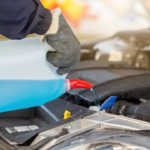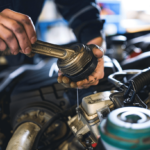You’ve likely heard the squeal of worn brake pads or felt the unsettling vibration when pressing the brake pedal. These are just two signs that it’s time to replace your car’s brake pads. But there’s more to this critical maintenance task than meets the eye. Understanding the lifespan of brake pads, recognizing early warning signs, and knowing how your driving habits impact wear can save you from costly repairs and, more importantly, guarantee your safety on the road. Let’s examine the nuances of brake pad replacement timing and what factors you should consider to keep your vehicle’s braking system in top condition.
Key Takeaways
- Replace brake pads when the thickness is less than a quarter-inch.
- Consider replacement if you hear squealing or grinding noises while braking.
- Follow manufacturer guidelines, typically recommending replacement every 25,000 to 65,000 miles.
- Replace sooner if driving in urban environments or with aggressive habits.
- Conduct regular inspections every 10,000 to 20,000 miles to assess pad wear.
Table of Contents
Understanding Brake Pad Lifespan
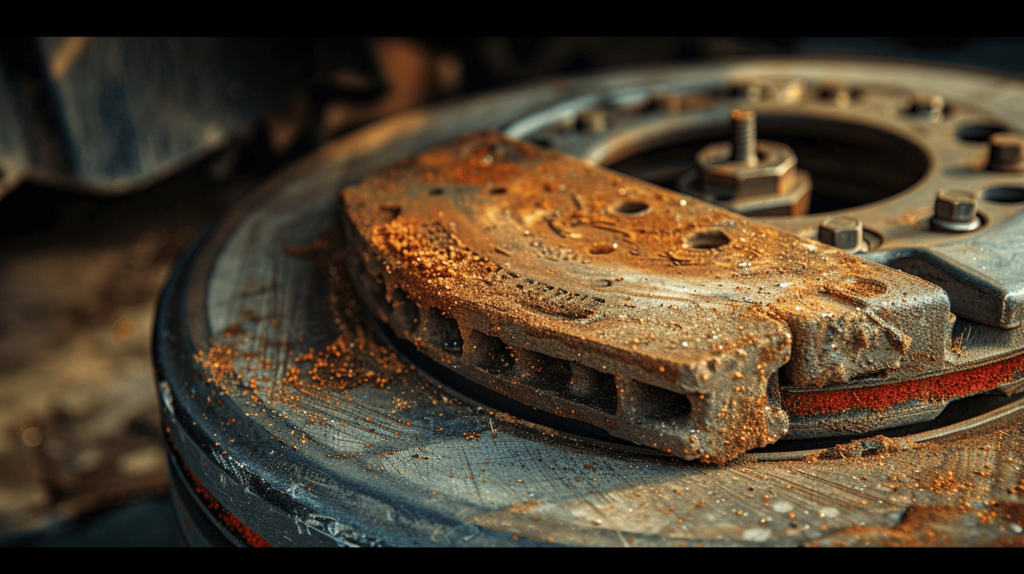
Brake pad lifespan varies greatly, typically ranging from 25,000 to 65,000 miles, depending on your driving habits and environmental conditions. Urban driving, with its frequent stop-and-go traffic, often shortens brake pad life to about 30,000-35,000 miles. In contrast, highway driving can extend your brake pad lifespan to 80,000 miles or more, due to less frequent braking.
It’s essential to understand that brake pads lose material with each use, gradually wearing down over time. This wear directly impacts your vehicle’s stopping distance, making regular inspections necessary. You should visually check your brake pads periodically, looking for signs that you need to replace them. If the pad thickness is less than a quarter-inch, it’s time for immediate replacement.
Your driving habits greatly influence brake pad wear. Frequent hard braking, carrying heavy loads, or driving in hilly terrain can accelerate wear rates. To maximize your brake pad lifespan, adopt smoother braking techniques and anticipate stops.
Signs of Worn Brake Pads
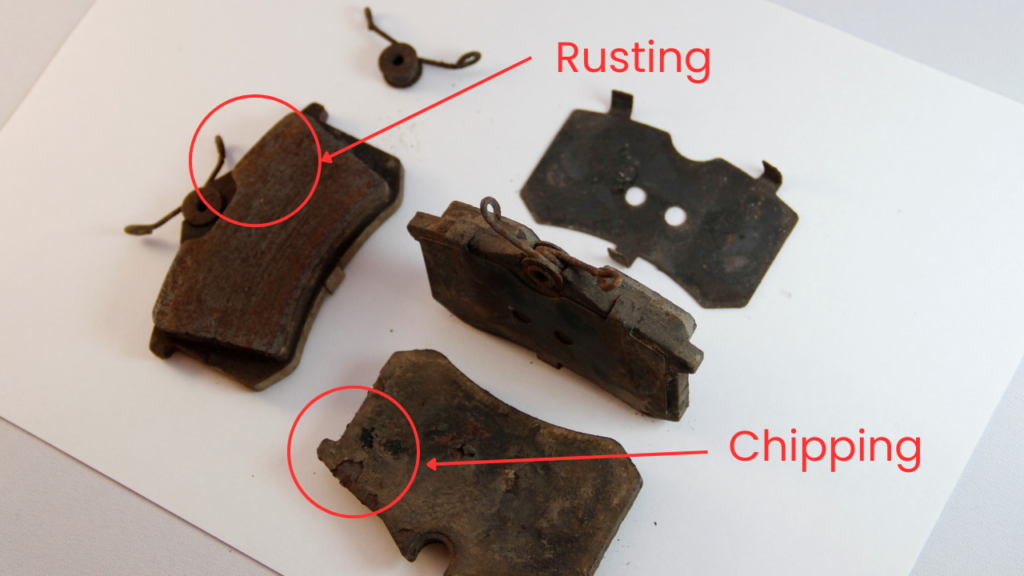
Understanding the lifespan of your brake pads is essential, but it’s just as vital to recognize the telltale signs that they’re wearing out and need replacement. Your vehicle’s braking system will often provide clear indicators when it’s time to replace the brake pads.
One of the most common signs you need new brake pads is a squealing or screeching noise when applying the brakes. This sound is typically caused by a built-in wear indicator. If you hear a deep, grinding sound, it’s a severe warning that your brake pads have worn down completely, potentially damaging the rotors.
Here’s a quick reference table for identifying worn brake pads:
| Sign | Cause | Action Required |
|---|---|---|
| Squealing noise | Wear indicator | Inspect pads |
| Grinding sound | Metal-on-metal contact | Immediate replacement |
| Thin pads (<1/4 inch) | Normal wear | Plan replacement |
Visual inspection can also reveal thin brake pads, indicating it’s time for replacement. If your brake pedal feels unusually sensitive or unresponsive, it could signify worn brake pads. Additionally, pay attention to any dashboard warning lights related to your braking system, as they may indicate issues requiring professional diagnosis.
Mileage Guidelines for Replacement
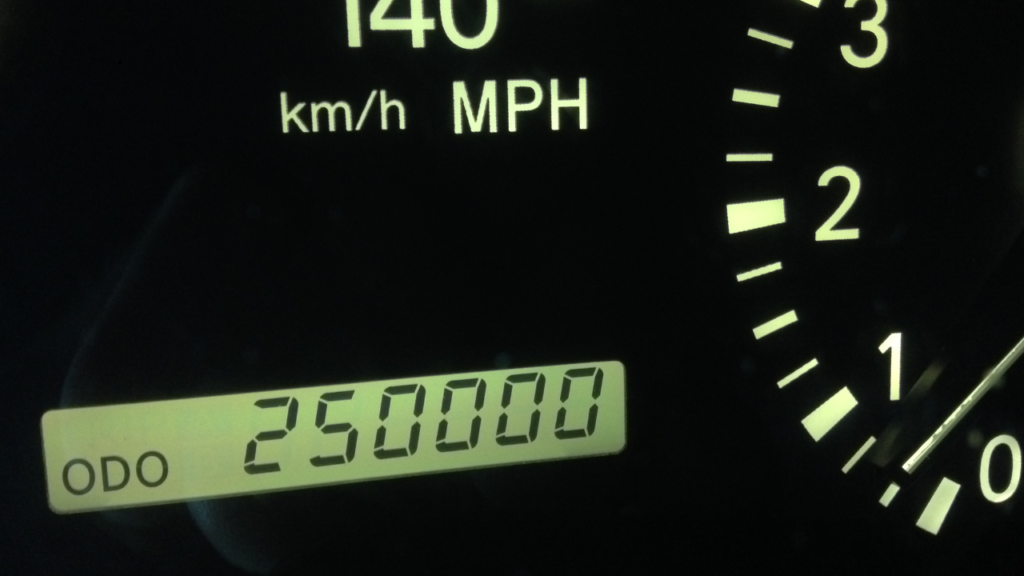
Adhering to mileage-based guidelines can help you determine when it’s time to replace your vehicle’s brake pads, guaranteeing ideal safety and performance. While manufacturers’ recommendations vary, brake pads generally need replacement every 25,000 to 65,000 miles. However, this range can fluctuate considerably based on your driving habits and environment.
If you primarily drive in urban areas with frequent stops, expect your brake pads to wear out faster, typically around 30,000 to 35,000 miles. Conversely, highway driving can extend pad life up to 80,000 miles or more. Some manufacturers suggest a more conservative approach, recommending replacement every 10,000 to 20,000 miles for peak safety.
To stay on top of brake pad maintenance, keep track of your vehicle’s mileage and schedule regular inspections. If your brake pads have worn down to less than a quarter-inch thick (approximately 7mm), it’s time for replacement.
Impact of Driving Habits
Your driving habits play an important role in determining how quickly your brake pads wear out, directly impacting their lifespan and replacement frequency.
Aggressive driving, characterized by hard braking and rapid acceleration, can greatly reduce brake pad lifespan, causing them to wear out within 25,000 miles or less. This accelerated wear necessitates more frequent replacements, increasing maintenance costs.
Urban environments with frequent stop-and-go traffic typically result in a brake pad lifespan of 30,000 to 35,000 miles due to increased engagement. In contrast, highway driving with minimal braking can extend brake pad life to 80,000 miles or more, as pads experience less wear from infrequent use.
It’s vital to be aware of habits like riding the brake pedal, which can accelerate wear rates and lead to premature replacement needs.
To maximize brake pad lifespan, regularly monitor your braking behavior and adjust your driving habits accordingly. Pay attention to wear indicators and listen for screeching noises, which signal the need to replace your brake pads.
Importance of Regular Inspections
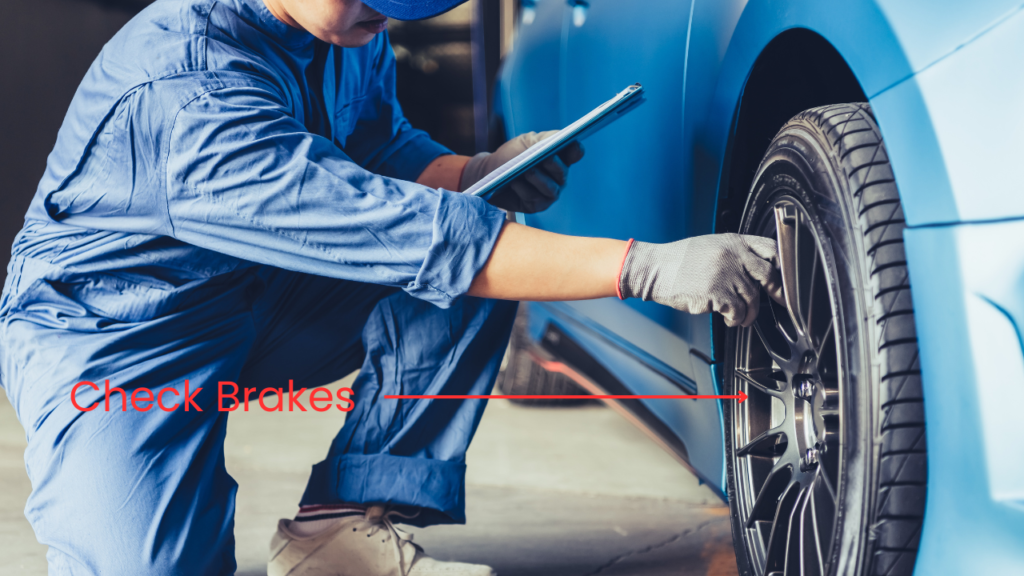
Through regular brake inspections, you’ll safeguard your vehicle’s performance and guarantee excellent safety on the road. These routine checks are essential for identifying wear and tear on brake pads and shoes, potentially preventing costly repairs. You should conduct visual inspections to monitor brake pad thickness; if they measure less than a quarter-inch, schedule an immediate inspection.
Regular inspections can detect warning signs that indicate your brake pads are worn and need replacement soon. These include:
- Squeaking or grinding noises when braking
- Vibrations in the steering wheel during deceleration
- Decreased braking responsiveness
- Illuminated dashboard indicator lights
By adhering to recommended inspection intervals (every 10,000 to 20,000 miles), you’ll maintain peak brake performance and safety. These checks allow technicians to assess the condition of your entire brake system, including rotors and calipers, ensuring all components are functioning correctly.
Don’t overlook the importance of monitoring dashboard indicator lights, as they can alert you to potential brake system issues. Timely inspections based on these warnings can help maintain braking efficiency and prevent more severe problems from developing.
Brake Pad Materials Comparison
Selecting the right brake pad material is essential for maximizing your vehicle’s braking performance, longevity, and maintenance costs. You’ll typically encounter three main types of brake pads: organic, metallic, and ceramic, each with distinct characteristics.
Organic brake pads, made from non-asbestos materials, offer quiet operation and smooth stopping power. They’re gentle on rotors but wear out faster, often requiring replacement every 25,000 to 30,000 miles. If you prioritize a comfortable ride and don’t mind more frequent maintenance, organic pads might suit your needs.
Metallic brake pads incorporate metal fibers, excelling in heat dissipation and high-stress performance. They’re ideal for aggressive driving or heavy-duty applications. However, you’ll notice increased noise and potentially faster rotor wear. Consider metallic pads if you value performance over quietness.
Ceramic brake pads blend ceramic materials with other components, offering a balanced solution. They produce less dust, operate quietly, and generally last longer—up to 70,000 miles in some cases. While more expensive upfront, their longevity can offset costs over time. If you’re seeking a low-maintenance option with consistent performance, ceramic pads are worth considering.
Your driving habits and vehicle requirements should guide your brake pad material choice, ensuring maximum safety and efficiency.
DIY Vs Professional Replacement
When considering brake pad replacement, you’ll face an essential decision between tackling the job yourself or entrusting it to a professional mechanic.
DIY brake pad replacement can save you labor costs, but it requires sufficient knowledge of brake systems and proper tools to guarantee safety and effectiveness. If you’re confident in your skills, follow these steps:
- Consult a step-by-step guide specific to your vehicle model
- Gather all necessary tools and replacement parts
- Adhere to safety precautions, including proper jacking and wheel removal
- Bleed the brake system post-installation to prevent brake failure
Professional mechanics offer expertise and thorough inspections, potentially identifying hidden issues beyond the pads. They ascertain the job is done correctly, often providing warranties on parts and labor. Regular maintenance checks by professionals can detect the need for brake pad replacement before signs become severe, potentially saving you from costly repairs.
Consider your technical skills, available time, and comfort level when deciding. While DIY can be cost-effective, professional services offer peace of mind and may catch potential problems early.
Ultimately, your choice should prioritize safety and the long-term health of your vehicle’s brake system.
Cost Considerations for Brake Maintenance
Three key factors influence the cost of brake maintenance: the type of vehicle you own, the quality of parts you choose, and whether you opt for DIY or professional service. Brake pad replacement typically ranges from $100 to $300 per axle, varying based on these factors. It’s vital to budget for this maintenance every 10,000 to 20,000 miles to avoid unexpected expenses.
Regular brake inspections, costing $50 to $100, can help identify issues early and prevent more costly repairs. Neglecting maintenance may lead to rotor damage, resulting in replacements costing $300 to $700. To manage costs effectively, research and compare prices for brake parts and services in advance.
If you’re considering DIY brake maintenance, factor in the cost of tools and the time investment required. While this approach can save money, it’s important to weigh it against the expertise and warranty offered by professional services.
Frequently Asked Questions About Changin Brake Pads.
How Do You Know if Brake Pads Need Replacing?
You’ll know your brake pads need replacing if you hear squeaking or grinding noises, feel vibrations while braking, or notice reduced braking efficiency. Check pad thickness; if it’s less than 1/4 inch, replace them immediately.
How to Tell if Brake Pads Are Worn?
In a world where your brakes could save your life, you’ll recognize worn pads by deafening squeals, grinding noises, or steering wheel vibrations. Check pad thickness through wheel spokes; if under 7mm, seek professional evaluation immediately.
How Long Should Brake Pads Last?
You’ll typically find brake pads lasting 25,000 to 65,000 miles. Your driving habits greatly impact longevity. Urban driving reduces lifespan to 30,000-35,000 miles, while highway use can extend it beyond 80,000 miles. Regular inspections are essential for timely replacement.
Should I Replace All 4 Brake Pads at Once?
You should replace all four brake pads simultaneously. It’s more cost-effective, guarantees balanced braking performance, and prevents uneven wear. If the front pads are considerably worn compared to the rear, replacing all four maintains peak safety and efficiency during your vehicle’s operation.


